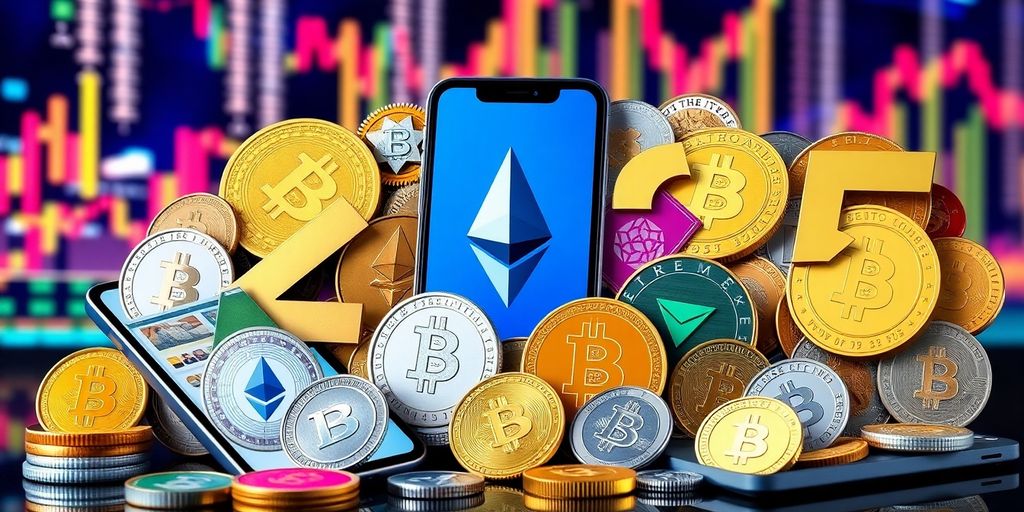As more people get interested in cryptocurrencies, knowing where to buy crypto coin becomes essential. The landscape is always changing, with new exchanges popping up and regulations shifting. This guide is here to help you navigate the world of crypto buying in 2025, making it easier to find a trustworthy platform and manage your investments safely.
Key Takeaways
- Look for exchanges with strong security features and user-friendly interfaces.
- Understand the differences between centralized, decentralized, and peer-to-peer platforms.
- Be aware of all fees, including trading, withdrawal, and any hidden costs.
- Stay updated on regulatory changes that can affect your buying options.
- Choose the right wallet type to keep your crypto secure.
Identifying Reliable Crypto Exchanges

Key Features to Look For
Okay, so you’re trying to figure out where to buy crypto in 2025. Makes sense! First things first, let’s talk about what makes a crypto exchange worth your time. It’s not just about which one has the coolest logo, right? You need to dig a little deeper.
- User Interface: Is it easy to use? Can you find what you need without wanting to throw your computer out the window? A good interface is super important, especially if you’re new to this.
- Supported Cryptocurrencies: Does the exchange offer the coins you’re actually interested in? Some exchanges have a ton, others are more limited. Make sure they have what you want to trade.
- Trading Volume and Liquidity: High trading volume usually means you can buy and sell without huge price swings. Low liquidity? You might get stuck with coins you can’t easily sell.
- Payment Methods: Can you use your preferred payment method? Some only take bank transfers, others are cool with credit cards or even PayPal.
Choosing the right crypto exchange depends on what you need. For beginners, something like Coinbase might be a good start. If you want low fees, Binance.US could be an option. Kraken is known for its security, and Gemini is all about following the rules.
Security Measures to Consider
Seriously, security is a HUGE deal. You don’t want your hard-earned crypto disappearing because the exchange got hacked. Here’s what to look for:
- Two-Factor Authentication (2FA): This is a must-have. It adds an extra layer of security beyond just your password.
- Cold Storage: Does the exchange store most of its crypto offline? This makes it way harder for hackers to get to it.
- Insurance: Some exchanges have insurance policies that cover losses in case of a hack. It’s not a guarantee, but it’s a nice safety net.
- Regular Security Audits: Does the exchange get checked out by third-party security firms? If so, that’s a good sign.
Gemini and Kraken are often mentioned as some of the safest exchanges around. They take security pretty seriously, which is always good.
User Reviews and Ratings
Don’t just take the exchange’s word for it! See what other people are saying. Check out reviews on different sites and see what the general consensus is.
- Look for patterns: Are a bunch of people complaining about the same thing? That’s a red flag.
- Consider the source: Is the review site reputable? Some sites might be biased.
- Don’t rely on just one review: Read a bunch of them to get a well-rounded picture.
It’s also worth checking out Bitcoin exchanges to see what people are saying about their experiences. Remember, no exchange is perfect, but you want to find one with a solid reputation and happy users.
Understanding Different Types of Crypto Platforms
Okay, so you’re ready to buy some crypto in 2025. Awesome! But before you jump in, it’s good to know where you can actually get your digital coins. It’s not like there’s just one crypto store. There are different types of platforms, each with its own quirks and benefits. Let’s break it down.
Centralized Exchanges Explained
Think of centralized exchanges (CEXs) like the stock market, but for crypto. They’re run by a company that acts as an intermediary between buyers and sellers. These are usually the big names you hear about. They offer a user-friendly experience, especially for beginners. You can usually buy crypto with regular money (like USD or EUR) pretty easily. They also tend to have more features, like advanced trading tools and staking options. The downside? You’re trusting a central authority with your funds. If the exchange gets hacked or goes bust, you could lose your money. Also, they usually require you to hand over your personal information (KYC – Know Your Customer) to comply with regulations.
- Generally easy to use.
- Often support many different cryptocurrencies.
- Can offer additional services like staking and lending.
Decentralized Exchanges Overview
Decentralized exchanges (DEXs) are the opposite of CEXs. There’s no central authority. Instead, trades happen directly between users using something called smart contracts. It’s like a digital swap meet. The main advantage is that you have complete control over your funds. You connect your own wallet directly to the DEX, so you don’t have to trust anyone else with your crypto. DEXs also tend to be more private, as they often don’t require KYC. However, they can be more complicated to use, especially if you’re new to crypto. The fees can also be higher than on CEXs, depending on the network you’re using. Plus, the top crypto exchanges usually have more liquidity, meaning it might be harder to buy or sell large amounts of crypto on a DEX without affecting the price.
- You maintain control of your private keys.
- Increased privacy (often no KYC).
- Potentially access to coins not listed on CEXs.
Decentralized exchanges are a key part of the DeFi (decentralized finance) movement. They aim to create a more open and accessible financial system, free from the control of traditional institutions.
Peer-to-Peer Platforms
Peer-to-peer (P2P) platforms connect buyers and sellers directly. It’s like a classifieds section for crypto. The platform acts as an escrow service, holding the crypto until both parties have fulfilled their obligations. This can be a good option if you want more control over the price you pay or receive, or if you want to use a specific payment method that’s not supported by CEXs or DEXs. However, P2P platforms can be riskier than CEXs or DEXs, as you’re dealing directly with other individuals. You need to be careful about scams and fraud. Always use the platform’s escrow service and never release the crypto until you’ve received payment. Also, be aware that P2P platforms may have lower liquidity than exchanges.
- Direct interaction with buyers/sellers.
- More flexible payment options.
- Potential for better prices (but also higher risk).
Evaluating Fees and Costs
It’s easy to get caught up in the excitement of crypto, but don’t forget the fees! They can really eat into your profits if you’re not careful. Understanding the different types of fees and how they work is super important before you start trading. You want to make sure you’re getting the best deal possible and not losing money unnecessarily. Let’s break down what to look for.
Trading Fees Breakdown
Trading fees are what exchanges charge you for buying or selling crypto. These can vary a lot depending on the exchange and your trading volume. Some exchanges use a "maker-taker" model, where "makers" (those who place orders that aren’t immediately filled) pay lower fees than "takers" (those who fill existing orders). Other exchanges might have a flat fee structure. For example, low trading fees can significantly impact your profitability, especially if you’re a frequent trader.
Here’s a simple example of how maker-taker fees might work:
| Role | Action | Fee |
|---|---|---|
| Maker | Places a limit order that isn’t filled | 0.10% |
| Taker | Fills an existing order | 0.20% |
It’s also worth noting that some platforms offer reduced fees for users who hold a certain amount of the exchange’s native token. Always check the fine print!
Withdrawal and Deposit Fees
Beyond trading fees, you’ll also encounter fees for moving your crypto in and out of the exchange. Withdrawal fees are charged when you send crypto from the exchange to your wallet, while deposit fees are charged when you send crypto to the exchange. Some exchanges offer fee-free deposits, but withdrawals almost always have a fee to cover network costs. These fees can vary widely depending on the cryptocurrency and the network congestion. Always check the withdrawal and deposit fees before making a transaction.
Here are some things to keep in mind:
- Withdrawal fees are usually higher for cryptocurrencies with slower transaction times.
- Some exchanges offer discounts on withdrawal fees if you use their native token.
- Always double-check the withdrawal address to avoid losing your funds.
Hidden Costs to Watch Out For
Sometimes, exchanges have costs that aren’t immediately obvious. These "hidden" costs can include things like conversion fees (when you convert one crypto to another), inactivity fees (if you don’t trade for a certain period), or even slightly inflated prices compared to other exchanges. It’s important to read the terms and conditions carefully and compare prices across different platforms to make sure you’re getting a fair deal. Keep an eye out for hidden costs to avoid surprises.
It’s easy to focus solely on the trading fees, but don’t forget to factor in all the other potential costs. A seemingly low-fee exchange might end up being more expensive overall if they have high withdrawal fees or unfavorable conversion rates. Always do your research and compare all the costs before choosing an exchange.
Here are some tips to avoid hidden costs:
- Read the fine print: Always read the terms and conditions carefully to understand all the potential fees.
- Compare prices: Compare prices across different exchanges to make sure you’re getting a fair deal.
- Be aware of inactivity fees: If you don’t plan to trade frequently, choose an exchange that doesn’t charge inactivity fees.
Navigating Regulatory Changes
It’s 2025, and if you’re buying or trading crypto, you absolutely need to keep up with the rules. Things are changing fast, and what was okay last year might not be okay today. It can be a headache, but ignoring it could cost you.
Impact of Regulations on Exchanges
Regulations are really shaking things up for exchanges. Some smaller ones are struggling to keep up with the costs of compliance, and we’re seeing some consolidation in the market. Larger exchanges are investing heavily in compliance departments, but that also means they might be more selective about which coins they list. For example, some exchanges are delisting coins that are deemed securities by the SEC. This impacts what you can buy and where you can buy it. The SEC enforcement role is definitely something to watch.
How to Stay Compliant
Staying compliant isn’t just for exchanges; it’s for users too. Here’s what you should be doing:
- Know Your Exchange: Make sure the exchange you’re using is registered and compliant in your jurisdiction. Check their website for licensing information.
- Keep Records: Document all your transactions, including dates, amounts, and the parties involved. This will be a lifesaver if you ever get audited.
- Stay Informed: Follow regulatory news and updates from reputable sources. Don’t rely on random posts on social media.
It’s easy to get overwhelmed by all the legal jargon, but there are resources available to help. Many crypto tax software programs now offer compliance tools, and some law firms specialize in crypto regulations. Don’t be afraid to seek professional advice if you’re unsure about something.
Future Trends in Crypto Regulation
Predicting the future is tough, but here are a few things I think we’ll see more of:
- Increased International Cooperation: Regulators around the world are starting to work together to create consistent rules for crypto. This could lead to more standardized regulations globally.
- Focus on Stablecoins: Stablecoins are under intense scrutiny, and I expect we’ll see stricter rules about reserves and auditing.
- More Clarity on Token Classification: The big question of whether a token is a security or a commodity will hopefully become clearer. This will have a huge impact on which regulations apply to different crypto assets.
It’s a wild west out there, but staying informed and proactive is the best way to protect yourself. Keep an eye on how crypto regulations are evolving.
Choosing the Right Wallet for Your Crypto
Okay, so you’ve bought some crypto. Congrats! Now you need a safe place to keep it. Think of a crypto wallet like your bank account, but you’re in total control. There are a bunch of options, and picking the right one can feel overwhelming. Let’s break it down.
Hot Wallets vs. Cold Wallets
Hot wallets and cold wallets are the two main types. Hot wallets are connected to the internet, making them convenient for frequent trading. Cold wallets are offline, offering better security for long-term storage. Here’s a quick comparison:
| Feature | Hot Wallet | Cold Wallet |
|---|---|---|
| Connectivity | Online | Offline |
| Security | Lower | Higher |
| Convenience | High | Low |
| Best For | Frequent trading, small amounts | Long-term storage, large amounts |
Hot wallets are usually free and easy to set up, but they’re more vulnerable to hacking. Cold wallets cost money, but they give you peace of mind knowing your crypto is super secure. It’s a trade-off between convenience and security.
Best Wallets for Beginners
If you’re just starting out, a user-friendly wallet is key. Some popular options include:
- Exodus: Known for its simple interface and support for many cryptocurrencies.
- Trust Wallet: A mobile-first wallet with a built-in web3 browser.
- Crypto.com App: Offers a user-friendly interface and various features like staking and earning rewards.
These wallets are relatively easy to set up and use, even if you’re not a tech whiz. They also offer decent security features to protect your crypto. Remember to always back up your seed phrase!
Security Tips for Wallet Management
No matter which wallet you choose, security is paramount. Here are some tips to keep your crypto safe:
- Back up your seed phrase: This is your master key. Store it offline in a secure location.
- Enable two-factor authentication (2FA): Adds an extra layer of security to your account.
- Use a strong, unique password: Don’t reuse passwords from other websites.
- Beware of phishing scams: Never click on suspicious links or enter your seed phrase on untrusted websites.
- Keep your software updated: Regularly update your wallet software to patch security vulnerabilities.
It’s important to remember that you are your own bank when it comes to crypto. This means you’re responsible for the security of your funds. Take the time to learn about wallet security and implement best practices to protect your investments. Leaving crypto on exchanges is risky, so get yourself a wallet!
Exploring Payment Methods for Crypto Purchases

Bank Transfers and Credit Cards
Bank transfers and credit cards are still the most common ways people buy crypto. It’s familiar, and most exchanges support it. The downside? It can be slow. Bank transfers might take a few days to clear, and credit card companies sometimes charge extra fees for crypto purchases. Plus, some banks might block transactions if they’re not crypto-friendly. Despite these drawbacks, the ease of use makes them a popular choice.
Using PayPal and Other Services
PayPal and similar services like Venmo are making it easier to buy crypto. The big advantage is speed and convenience. Most people already have accounts, so there’s no need to set up anything new. However, there are limitations. Not all cryptocurrencies are available on these platforms, and the fees can sometimes be higher than on dedicated crypto exchanges. Also, you might not be able to transfer your crypto to an external wallet, limiting what you can do with it.
Cash Purchases and ATMs
Cash is still king for some, and there are ways to use it to buy crypto. Crypto ATMs are popping up in more places, letting you buy Bitcoin and Ethereum with cash. The process is usually straightforward: you scan a QR code from your wallet, insert cash, and the crypto is sent to your wallet. The downside is that these ATMs often charge hefty fees, and you’ll likely need to provide ID for larger transactions. It’s convenient, but it comes at a cost.
Using cash offers a level of privacy that digital methods don’t, but it’s important to be aware of the higher fees and potential security risks involved with carrying large amounts of cash.
Staying Informed About Market Trends
It’s a wild ride in the crypto world, and things change fast. What’s hot today might be old news tomorrow. So, how do you keep up? Here’s the lowdown.
Following Crypto News Outlets
There are tons of places to get your crypto news, but not all are created equal. You want sources that are reliable and give you the straight facts, not just hype. I usually check a few different spots to get a well-rounded view. Staying updated with crypto news sites is super important.
Here are some types of news outlets to consider:
- Dedicated Crypto News Sites: These sites focus solely on crypto and blockchain tech. They often have in-depth articles, market analysis, and interviews.
- Mainstream Financial News: Places like Bloomberg and Reuters have started covering crypto more seriously. They can give you a broader economic perspective.
- Research Reports: Some firms put out reports on the state of the crypto market. These can be dense, but they’re packed with data.
Utilizing Social Media for Updates
Social media is a mixed bag. It’s great for getting quick updates and seeing what people are talking about, but it’s also full of noise and scams. You have to be careful about who you trust. I find it helpful to follow:
- Industry Leaders: People who have a proven track record and share thoughtful insights.
- Project Accounts: The official accounts of the crypto projects you’re interested in. Just remember they’re trying to sell you something.
- Independent Analysts: People who do their own research and aren’t afraid to call out BS.
Remember to always double-check information you see on social media. It’s easy for rumors and misinformation to spread like wildfire.
Joining Crypto Communities
Being part of a crypto community can be really helpful. You can ask questions, share ideas, and learn from others. But, like social media, you need to be careful. Some communities are full of shillers and scammers. Look for communities that are:
- Active and Engaged: A good community has lots of people participating and discussing different topics.
- Moderated: The mods should be keeping out the spam and scams.
- Diverse: A mix of newbies and experienced people can make for a more valuable learning experience.
Finding the right crypto signals telegram groups can be a game changer.
Wrapping It Up
So there you have it! Buying crypto in 2025 doesn’t have to be a headache. With the right info and tools, you can jump into the market with confidence. Remember to do your homework, pick a trustworthy exchange, and keep your coins safe. Whether you’re in it for the long haul or just dipping your toes in, staying informed is key. The crypto world is always changing, so keep an eye on the trends and updates. Happy investing!
Frequently Asked Questions
What should I look for in a crypto exchange?
When choosing a crypto exchange, check for user-friendly features, security measures, and positive reviews from other users.
What are the main types of crypto platforms?
The main types of platforms are centralized exchanges, decentralized exchanges, and peer-to-peer platforms.
How do I understand the fees associated with buying crypto?
Look at the breakdown of trading fees, withdrawal and deposit fees, and be aware of any hidden costs.
How do regulations affect crypto exchanges?
Regulations can change how exchanges operate, so it’s important to stay informed about any updates that may affect your trading.
What type of wallet should I use for my crypto?
You can choose between hot wallets, which are online and easy to use, and cold wallets, which are offline and more secure.
What payment methods can I use to buy crypto?
You can buy crypto using bank transfers, credit cards, services like PayPal, or even cash at ATMs.










